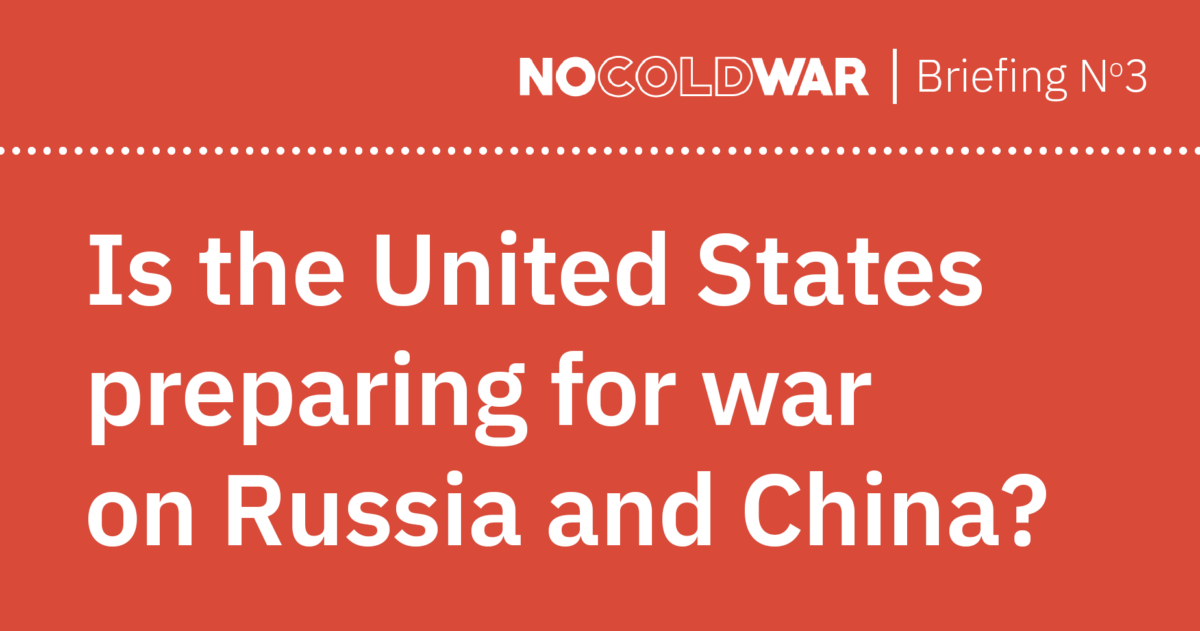The new Cold War is rapidly heating up, with severe consequences for people around the world. Our series, Briefings, provides the key facts on these matters of global concern.
![]() English | Español | Português | Deutsch | Français
English | Español | Português | Deutsch | Français
The war in Ukraine demonstrates a qualitative escalation of the United States’ willingness to use military force. In recent decades, the US launched wars on developing countries such as Afghanistan, Iraq, Libya, and Serbia. In these campaigns, the US knew it enjoyed overwhelming military superiority and that there was no risk of a nuclear retaliation. However, in threatening to bring Ukraine into the North Atlantic Treaty Organisation (NATO), the US was prepared to risk crossing what it knew to be the ‘red lines’ of the nuclear armed state of Russia. This raises two questions: why has the US undertaken this escalation, and how far is the US now prepared to go in the use of military force against not only the Global South but major powers such as China or Russia?
Using Military Force to Compensate for Economic Decline
The answer to ‘why’ is clear: the US has lost in peaceful economic competition to developing countries in general and China in particular. According to the International Monetary Fund (IMF), in 2016 China overtook the US as the world’s largest economy. As of 2021, China accounted for 19% of the global economy, compared to the US at 16%. This gap is only growing wider, and, by 2027, the IMF projects that China’s economy will outsize the US by nearly 30%. However, the US has maintained unrivalled global military supremacy – its military expenditure is larger than the next nine highest spending countries combined. Seeking to maintain unipolar global dominance, the US is increasingly substituting peaceful economic competition with military force.
A good starting point to understand this strategic shift in US policy is the speech given by US Secretary of State Antony Blinken on 26 May 2022. In it, Blinken openly admitted that the US does not seek military equality with other states, but military supremacy, particularly with respect to China: ‘President Biden has instructed the Department of Defense to hold China as its pacing challenge, to ensure that our military stays ahead’. However, with nuclear armed states such as China or Russia, military supremacy necessitates achieving nuclear supremacy – an escalation above and beyond the current war in Ukraine.
The Pursuit of Nuclear Primacy
Since the beginning of the 21st century, the US has systematically withdrawn from key treaties limiting the threat of use of nuclear weapons: in 2002, the US unilaterally exited from the Anti-Ballistic Missile Treaty; in 2019, the US abandoned the Intermediate Nuclear Forces Treaty; and, in 2020, the US withdrew from the Open Skies Treaty. Abandoning these treaties strengthened the US’ ability to seek nuclear supremacy.
The ultimate aim of this US policy is to acquire ‘first strike’ capacity against Russia and China – the ability to inflict damage with a first use of nuclear weapons against Russia or China to the extent that it effectively prevents retaliation. As John Bellamy Foster has noted in a comprehensive study of this US nuclear build up, even in the case of Russia – which possesses the world’s most advanced non-US nuclear arsenal – this would ‘deny Moscow a viable second-strike option, effectively eliminating its nuclear deterrent altogether, through “decapitation”’. In reality, the fallout and threat of nuclear winter from such a strike would threaten the entire world.
This policy of nuclear primacy has long been pursued by certain circles within Washington. In 2006, it was argued in the leading US foreign policy journal Foreign Affairs that ‘It will probably soon be possible for the United States to destroy the long-range nuclear arsenals of Russia or China with a first strike’. Contrary to these hopes, the US has not yet been able to achieve a first strike capacity, but this is due to development of hypersonic missiles and other weapons by Russia and China – not a change in US policy.
From its attacks on Global South countries to its increased willingness to go to war with a great power such as Russia to attempting to gain first strike nuclear capacity, the logic behind the escalation of US militarism is clear: the United States is increasingly employing military force to compensate for its economic decline. In this extremely dangerous period, it is vital for humanity that all progressive forces unite to meet this great threat.
